Life Science

Code No. NKB-101T 50 ml x 2
NKB-101 250 ml x 2
NKB-201 250 ml x 1
NKB-301 250 ml x 1
Immunoreaction Enhancer Solution
Can Get Signal®
Description
Can Get Signal® is a solution containing an accelerator for antigen-antibody reactions. This reagent improves sensitivity, specificity, and signal-to-noise ration (S/N) for Western blotting, dot blotting, enzyme-linked immunosorbent assay (ELISA), etc. Solutions 1 and 2 refer to the reactions of the primary and secondary antibodies, respectively.
Features
- Enhances immunoassay signals up to several dozen times by maintaining low background signals.
- Can be used in combination with secondary antibodies labeled with peroxidase or alkaline phosphatase, etc.
- Can be used directly without dilution (ready-to-use).
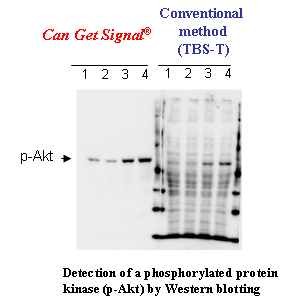
Applications
- Western blotting, dot blotting
- Enzyme-linked immunosorbent assay (ELISA),
Storage condition
Store at 4ºC
Components
This kit includes the following components. All reagents should be stored at 4ºC, and protected from light.
| Reagent Name | Code No. | |||
|---|---|---|---|---|
| NKB-101T | NKB-101 | NKB-201 | NKB-301 | |
| Solution 1 for primary antibody |
50 ml | 250 ml | 250 ml | - |
| Solution 2 for secondary antibody |
50 ml | 250 ml | - | 250 ml |
Typical reaction flow
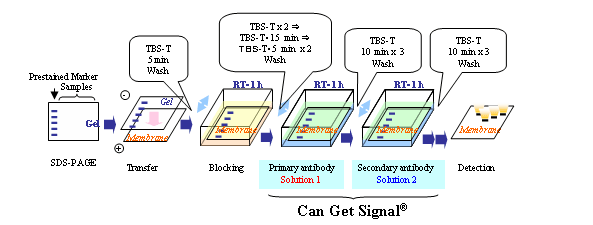
Flow chart of western blotting with Can Get Signal®
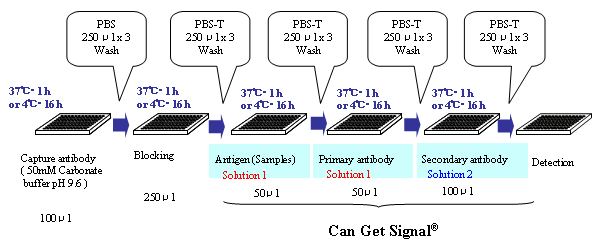
Flow chart of ELISA with Can Get Signal®
Application Data
Experiment 1. Detection of phosphorylated proteins by Western blotting
Phosphorylated Akt and ERK were detected by Western blotting analysis using Can Get Signal® and a conventional method (TBS-T). As a result, the signal intensities of the target bands obtained with Can Get Signal® were greater than those of the conventional method. The background level of the experiment with Can Get Signal® was also significantly lower than that of the conventional method. The results suggest that Can Get Signal® improves the sensitivity and specificity of Western blotting analysis.
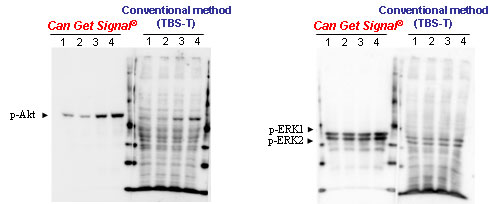
Sample:Cultured bovine adrenal medulla cells
- Control (H2O)
- Insulin (1 nM, stimulated for 5 min)
- Insulin (10 nM, stimulated for 5 min)
- Insulin (100 nM, stimulated for 5 min)
Antibodies:
<p-Akt>
Primary antibody:Anti Phospho-Akt rabbit polyclonal antibody (1:2,000 dilutioin)
Secondary antibody:Anti rabbit-HRP antibody (1:20,000 dilution)
<p-ERK>
Primary antibody:Anti Phospho-ERK monoclonal antibody(1:2,000 dilutioin)
Secondary antibody:Anti mouse-HRP antibody (1:20,000 dilution)
Fig.1 Detection of phosphorylated protein kinases (p-Akt, p-ERK1 and p-ERK2) by Western blotting with Can Get Signal® and a conventional method
*The data was kindly provided by Dr. Yanagita from the Department of Pharmacology, Faculty of Medicine, University of Miyazaki.
Experiment 2. Detection of His-tagged proteins by Western blotting
His-tagged recombinant proteins were detected with Can Get Signal® and a conventional method (TBS-T). Can Get Signal® showed excellent greater sensitivity than the conventional method.
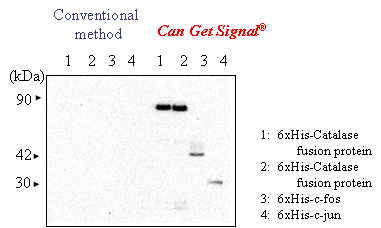
Antibodies:
Primary antibody:Anti his-tag rabbit polyclonal antibody (1:2,000 dilutioin)
Secondary antibody:Anti rabbit-IgG-HRP antibody (1:20,000 dilution)
Fig.2 Detection of His-tagged proteins by Western blotting
Experiment 3. Experiment 3. Detection of His-tagged proteins by ELISA
Sandwich ELISA (solid phase antibody: anti-ERK2 monoclonal antibody, primary antibody: anti-His tag polyclonal antibody, secondary antibody: anti-rabbit IgG-HRP antibody) was performed to detect his-tagged human MAP kinase (His-ERK2) synthesized by a cell-free protein synthesis system. Can Get Signal® showed an excellent quantitative curve as a function of antigen concentration whereas the conventional method with TBS-T resulted in low signals.

Fig.3 Detection of His-tagged proteins by sandwich ELISA
To get a quote, contact us at info@toyobousa.com, or INQUIRY.